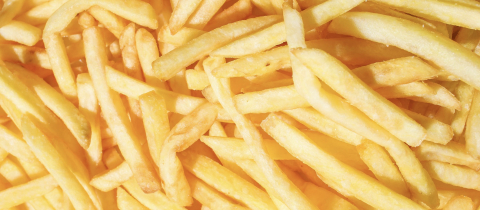So, you’re tired of eating lousy french fries. You’re sick of those limp dark brown grease sponges. What can you do? Make them! Let’s for a moment forget nutrition and health. In this area, french fries have no redeeming value. We eat them because we like them, in spite of what they may be doing to the lining of our arteries. So let’s at least make it worthwhile. A perfect fry has to be cooked through and through, should be a golden brown on the outside, cannot be limp and must not be saturated with grease. This is no small task. Numerous factors come into play. The type of potato, the shape of the fry, the oil used, the amount of oil, the temperature and the cooking technique.
Success, believe it or not, depends on dealing appropriately with the moisture content of the potato. Some of the moisture inside must be retained because the cooking of the starch in the potato depends on it. But if too much is retained, the potato will be soggy. As soon as the raw potato is dropped into the hot oil, the water on its surface converts to steam and blasts through the oil and escapes into the air. This is the sizzle you hear. It is soon replaced by moisture from the inside of the potato, which in turn changes to steam. Basically we have a continuous release of steam from the tuber. As long as this is happening, no fat is sucked into the potato. But should the temperature not be high enough to form steam, fat gets absorbed. It is the continuous outward pressure of the steam that prevents fat from entering. Evaporation of water from the surface of the potato cools it down. But after the water is gone, the temperature rises and the surface begins to turn brown. If the last of the water leaves just as the right colour is achieved, we’ll have a great fry. Now you see why frozen fries cause a difficulty. By the time they have been heated enough to expel steam, fat has already been absorbed. This is also the case with fresh cut potatoes that have not been properly dried. The surface moisture has too much of a cooling effect. Cooling also occurs if too many fries are dumped into too little oil. On the other hand, if the oil is too hot, the outside cooks before the inside does and furthermore there is not enough time for the water to escape. A soggy fry is the result.
So, here is what you do. Get some Russet Burbank potatoes, cut them into pieces no thicker than a quarter inch and dry them with a paper towel. Throw them into oil preheated to about 175°C, in other words, not maximum heat. This will ensure that the starch cooks and the potato dries but not to the point that grease is absorbed. Leave until pale brown, remove, drain and allow to cool. Then heat up the oil to 195°C, that is really hot, and put the pre cooked fries back in. The residual moisture will quickly evaporate and the outside will turn a golden brown. It will be better than anything you get at your local greasy spoon. Enjoy your fries, but not too often.
Want to comment on this article? Visit our FB Page!







